From Lamb to Wolf – 2021
The Project
In our narrative 2D puzzle game Reus, the player takes control over a lost soul that is able to switch between two worlds and thus changes appearance and abilities. Observing and exploring the environment of both worlds is necessary to solve the game's puzzles and find three key items that are needed to finish the level.
GENERAL INFO
•Made in Unity
• Assets created in Photoshop and ClipStudioPaint
•Second semester project at the HTW Berlin
•Team SveMaLeKa: Svenja Bette, Maja Abou Nasser,
Lei Xiao Rong, Kai Bittighöfer
My Role
• Lead Programming
• Level Design
• Sound Design
• Asset Concept and Line-art
• Key-asset coloring
• Sprite Animation
Explore the two realities and find the truth hidden inside the house of guilt.

A kitchen in one world...

... is the home of the hot tempered oven.

Explore the different rooms of the house.

Engage with the inhabitants of the different worlds.

To fulfill your destiny, you must help the creatures living in this house.
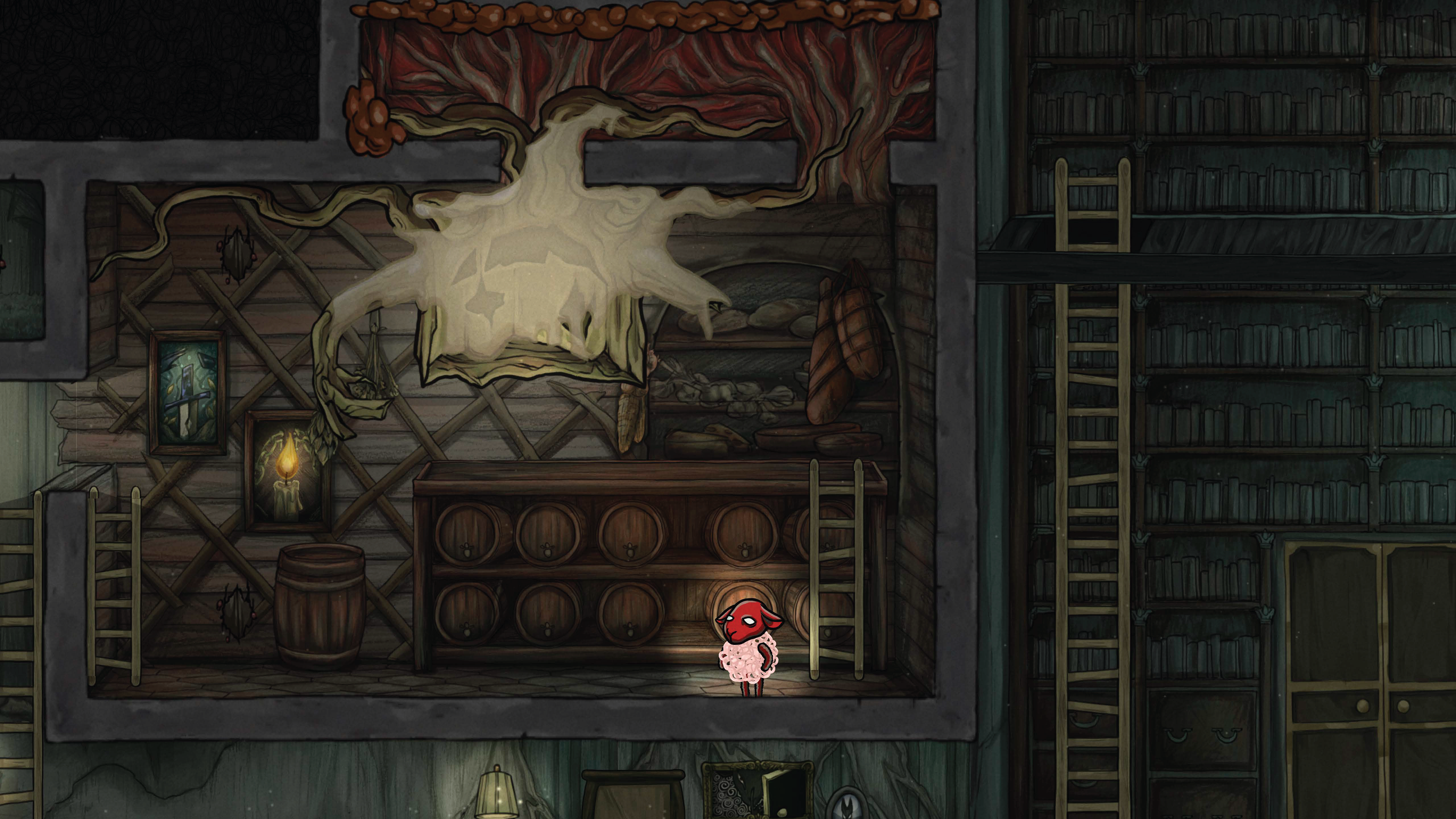
Solve riddles to make progress.
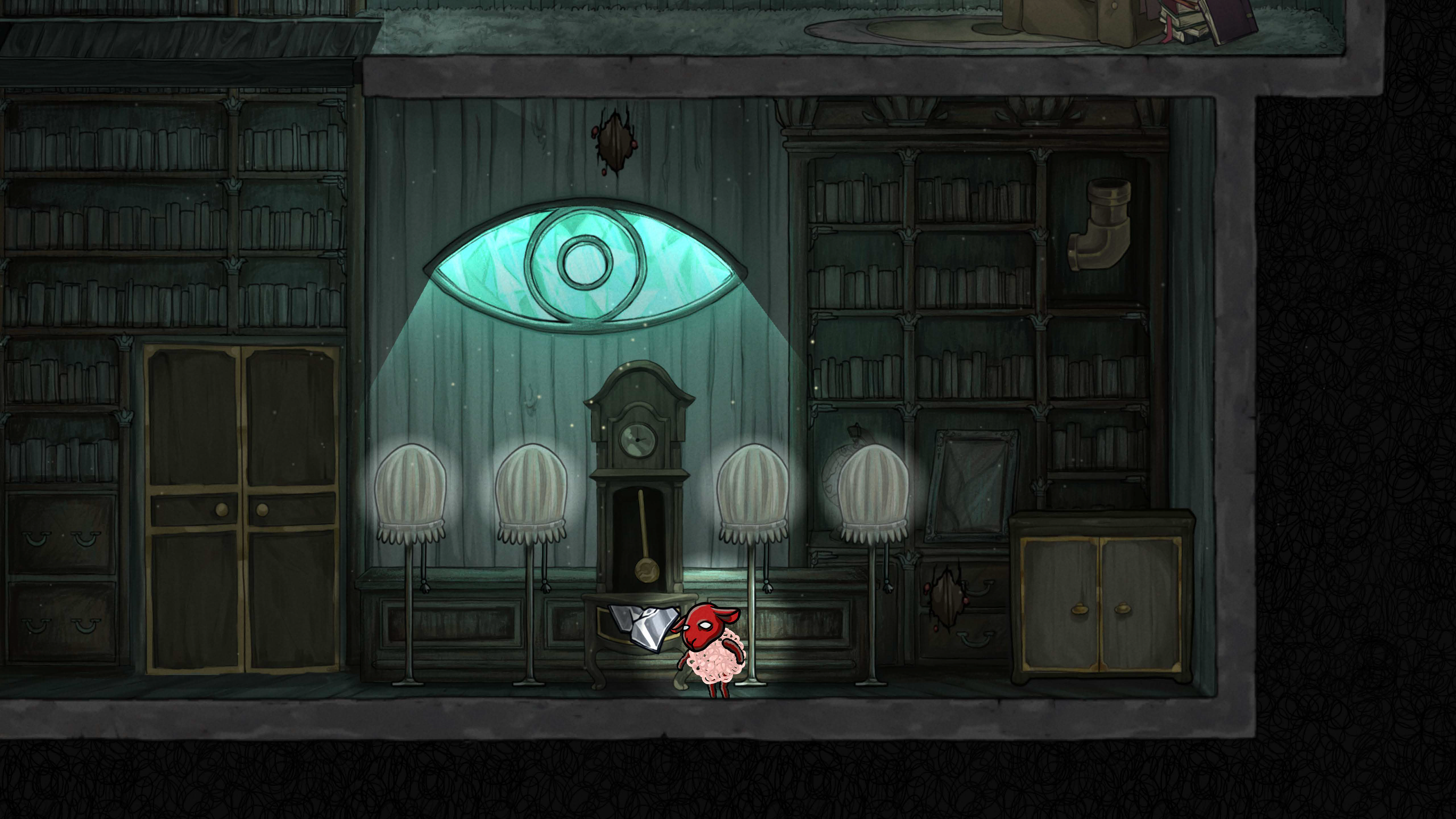
Find the mirror-shards to reveal the truth.

Switch between worlds to uncover what is unseen.

Be careful – not every encounter is pleasant!

Complete the mirror make your escape.
Progress
In our first draft, the game was meant to be played horizontally, which would have made the world a lot more linear. For our initial pitch, we simulated a world switch, in which both worlds are visible at all times and not interchangeable.
The player character was supposed to change size, speed and strength with the world switch. We maintained the concept of the character possessing over different skills, depending on which world they would move. However, features such as size turned out not to be reasonable to solve potential puzzles.
We started off by conceptualizing different rooms that need to be passed through. I designed a bathroom. Red triangles symbolize enemies, the light gray boxes with red outlines are wax that can be melted by utilizing fire items that can be collected by the player.
After rethinking the manner in which the level should be organized, we created fake screenshots to capture the game feel we wanted to achieve. In it, we already depicted some characters we wanted to include in the riddles: the Log Creature, the Furnace and the Blob. The riddle contained in these drafts is the completion of the broken pipe system.

In the first version, I wanted to use vivid colors, as they are not often found in horror games.

We settled for more toned down colors, however it was too bright.

The effect of strategically placed lights changed the impact of the ambience immensely. We knew we needed a stark contrast between the colors of the two worlds.
While not final, we decided that the most impactful design decision would be to make a stark contrast between the color palette of the two realities. Initially, we wanted to use colors of deep-sea and underwater creatures and plants, as they offer colors and themes not often explored in underworld-type settings.
Afterwards each of us was tasked with creating a mock-up of the entire map. We ended up working based off of my draft and discussed potential riddles, how the rooms were connected and where the key items would be hidden.
We could finally start working on our first prototype – each of us was given a key mechanic and went on to work on that. I worked on the world-switch mechanic. Meaning the change of gravity, size, speed and ability to destroy or repair things.
Video of my first prototype, exploring the world switch and ability change of the player-character.
First draft of the complete level.
After we combined our prototypes into one collective project, we assembled the entire level based on the draft. We made some adjustments, as we explored what would feel more natural in terms of exploration.
Now some elements were only visible in a specific world and the character would not be able to jump in one of the realities but instead use ladders.
Also switching worlds would only impact the room the player would be in while triggering the switch.
To compose a good result for the color palette and overall game feel, I sketched out the entire interior of the two worlds. Based on these, Maja made suggestions for coloring.
Artstyle
During our prototyping phase, we purposefully did not decide on a setting, so we would not be limited while figuring out the core mechanics of the game. However after having set up the base level, it was time to go into designing the assets and characters, so we needed to define our setting.
We wanted to convey a certain depth by giving the player an appearances with symbolic value, which resulted in the lamb – alive in one world and decayed in the other. Reus, meaning guilt, was meant to capture sins of the past, that the player character would carry and hinder them from fully finding peace and passing onto the afterlife. The setting of the house we've already set up was perfect, as mansions like these are often associated with memories and potentially troubled pasts.
The lamb is often associated with innocence. However sayings like "Wolf in Sheep clothing" and the appearance of the antichrist as a lamb contrast that. It makes the player character morally ambiguous.
To figure out which character design would look best in the game, we placed the different designs in the colored sketches.











We incorporated the colored sketches into our prototype to make sure the game feel was meeting our expectation and furthermore to make it clear to play testers, what was actually happening in the level.
Now the player could also hide in closets to not be seen by enemies.





We wanted to keep everything very illustrative, as it would make the look reminiscent of fairytales and fables, which we deemed fitting, as the hidden story would be concerned with morality. Furthermore, it gave us the opportunity to implement decorations that are more inviting for exploration and observation.
For our first playable prototype I created sprite animations. The design for the playable characters was kept more simplistic and clean compared to the mansion, so it would be easier for players to focus.
One of my favorite tasks was to animate the Log Creature being covered by its own tree resin.
The switch from the more dark reality is surrounded by the fleshy growths found everywhere in that dimension.
Contrastingly, the switch in the other world peeks through broken walls. Notice that the color of the eyes corresponds with the world they lead to.
Below you will find several items I colored. Generally I outlines items that the players would be able to interact with, the backgrounds of some rooms and other general items. While Maja was tasked with coloring, Svenja and I assisted her by coloring some of the assets.


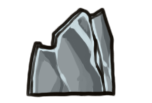

To highlight interacted objects, we put golden elements in them.

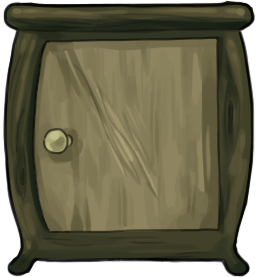
Or in this case, we placed scratch marks in the door.

It not only marks a special object, but also gives a hint to the story.
One of my tasks was to fill the house in Reus with life and substance.
To give it depth, I created several paintings hinting at an underlying story. The paintings also function as subtle hints to puzzles or references to characters in the game. For instance – on the right, the purple painting references the Blob character and the pointillism apple tree painting hints to the tree stump.
The most recognizable motifs however are the sheep and wolf. Attentive players are rewarded with clues to a deeper meaning of the story. Questions arise, such as "Who are the characters depicted? Is this our protagonist or people of their past? Do the changes of the paintings reflect a hidden truth?"
Pictures of the house


This painting hints to a possible hiding spot.

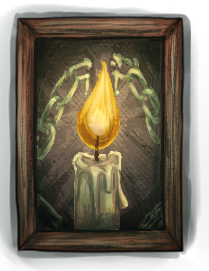

Images of sheep and wolves are hidden throughout the entire game.


The paintings shift between worlds.
Ultimately, we did not want to tell a clear cut story in our vertical slice. It has always been our intention to invite players to speculate about the hidden story and its deeper meaning. A full scale version of the game should provide even more hidden secrets, that are connected to events we implemented already. However, we also wanted to make sure the puzzle aspect is enjoyable enough, so that players who are not looking for a deeper story also find pleasure in our game.
Conclusion
We created Reus in a very challenging time – the middle of the pandemic. Therefore, our team was never united in a room throughout the entirety of the production. The fact that we managed to create this completely remote is an achievement I am very proud of.
We faced many challenges and it helped me personally immensely in future projects by teaching me a lot about my workflow and how to set boundaries. While I was often frustrated, because I took on a lot of the work and the vast majority of coding, although I was not familiar with programming at all, it pushed me out of many comfort zones and I grew with the challenges. We even decided to get back into working on it after the deadline, because we wanted to complete the vision we had. Now we can all look back at this project with pride.
